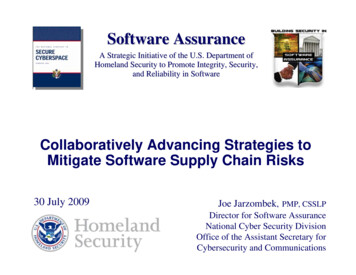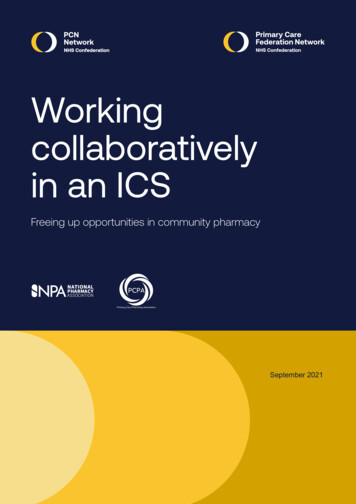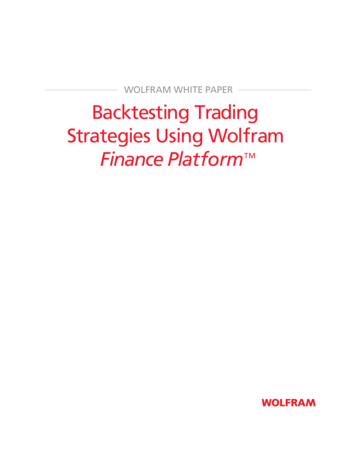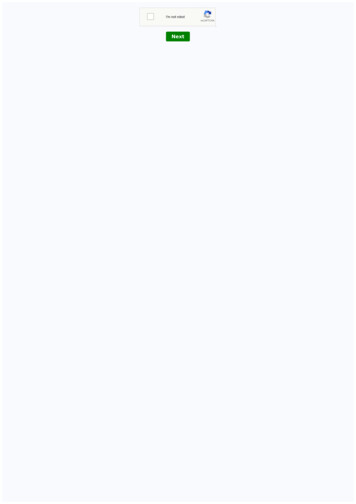
Transcription
Software AssuranceA Strategic Initiative of the U.S. Department ofHomeland Security to Promote Integrity, Security,and Reliability in SoftwareCollaboratively Advancing Strategies toMitigate Software Supply Chain Risks30 July 2009Joe Jarzombek, PMP, CSSLPDirector for Software AssuranceNational Cyber Security DivisionOffice of the Assistant Secretary forCybersecurity and Communications
DHS NCSD Software Assurance (SwA) ProgramThrough public-private collaboration promotes security and resilience of softwarethroughout the lifecycle; focused on reducing exploitable software weaknesses andaddressing means to improve capabilities that routinely develop, acquire, and deployresilient software products. Serves as a focal point for interagency public-private collaboration toenhance development and acquisition processes and capabilitybenchmarking to address software security needs.––– Hosts interagency Software Assurance Forums, Working Groups and training to provide public-privatecollaboration in advancing software security and providing publicly available resources.Provides collaboratively developed, peer-reviewed information resources on Software Assurance, viajournals, guides & on-line resources suitable for use in education, training, and process improvement.Provides input and criteria for leveraging international standards and maturity models used for processimprovement and capability benchmarking of software suppliers and acquisition organizations.Enables software security automation and measurement capabilities throughuse of common indexing and reporting capabilities for malware, exploitablesoftware weaknesses, and common attacks which target software.––Collaborates with the National Institute of Standards and Technology, international standardsorganizations, and tool vendors to create standards, metrics and certification mechanisms from whichtools can be qualified for software security verification.Manages programs to facilitate the adoption of Malware Attribute Enumeration Classification (MAEC),Common Weakness Enumeration (CWE), and Common Attack Pattern Enumeration andClassification (CAPEC).HomelandSecurityCybersecurity and Communications2
IT/software security risk landscape is a convergencebetween “defense in depth” and “defense in breadth”Enterprise Risk Managementand Governance are securitymotivatorsAcquisition could be consideredthe beginning of the lifecycle; notdevelopment“In the digital age, sovereignty isdemarcated not by territorial frontiersbut by supply chains.”– Dan Geer, CISO In-Q-TelSoftware Assurance provides a focus for:-- Secure Software Components,-- Security in the SDLC and-- Software Supply Chain Risk Management
*AcquisitionProgramSupplier“Supply chain introduces risks to American societythat relies on Federal Government for essentialinformation and services.”30 Sep 2005 changes to Federal AcquisitionRegulation (FAR) focus on IT SecurityFocuses on the role of contractors in security asFederal agencies outsource various IT functions.“Scope of Supplier Expansion and Foreign Involvement” graphic in DACS www.softwaretechnews.com SecureSoftware Engineering, July 2005 article “Software Development Security: A Risk Management Perspective” synopsisof May 2004 GAO-04-678 report “Defense Acquisition: Knowledge of Software Suppliers Needed to Manage Risks”4
Risk Management (Enterprise Project):Shared Processes & Practices // Different FocusesEnterprise-Level: Regulatory compliance Changing threat environment Business CaseProgram/Project-Level: Cost Schedule PerformanceSoftware Supply Chain Risk Managementtraverses enterprise and program/project interests5
Security is a Requisite Quality Attribute:Vulnerable Software Enables Exploitation Rather than attempt to break or defeatnetwork or system security, hackers areopting to target application software tocircumvent security controls. 75% of hacks occurred at applicationlevel– “90% of software attacks were aimed atapplication layer” (Gartner & Symantec, June 2006) most exploitable software vulnerabilitiesare attributable to non-secure codingpractices (and not identified in testing). Functional correctness must be exhibitedeven when software is subjected toabnormal and hostile conditionsSoftwareapplicationswith ionswith exploitablevulnerabilitiesIn an era riddled with asymmetric cyber attacks, claims about system reliability,integrity & safety must include provisions for built-in security of the enabling software.6
Software Assurance “End State” Objectives Government, in collaboration with industry / academia, raised expectationsfor product assurance with requisite levels of integrity and security: Helped advance more comprehensive software assurance diagnostic capabilities to mitigaterisks stemming from exploitable vulnerabilities and weaknesses;Collaboratively advanced use of software security measurement & benchmarking schemesPromoted use of methodologies and tools that enabled security to be part of normal business.Acquisition managers & users factored risks posed by the software supplychain as part of the trade-space in risk mitigation efforts: Information on suppliers’ process capabilities (business practices) would be used todetermine security risks posed by the suppliers’ products and services to the acquisitionproject and to the operations enabled by the software.Information about evaluated products would be available, along with responsive provisions fordiscovering exploitable vulnerabilities, and products would be securely configured in use.Suppliers delivered quality products with requisite integrity and madeassurance claims about the IT/software safety, security and dependability: Relevant standards would be used from which to base business practices & make claims;Qualified tools used in software lifecycle enabled developers/testers to mitigate security risks;Standards and qualified tools would be used to certify software by independent third parties;IT/software workforce had requisite knowledge/skills for developing secure, quality products. Enabling Software Supply Chain Transparency7
DHS Software Assurance Program OverviewProgram established in response to the National Strategy toSecure Cyberspace - Action/Recommendation 2-14:“DHS will facilitate a national public-private effort to promulgate bestpractices and methodologies that promote integrity, security, andreliability in software code development, including processes andprocedures that diminish the possibilities of erroneous code, maliciouscode, or trap doors that could be introduced during development.”DHS Program goals promote the security and resilience of softwareacross the development, acquisition, and operational life cycleDHS Software Assurance (SwA) program is scoped to address: Trustworthiness - No exploitable vulnerabilities or malicious logic exist inthe software, either intentionally or unintentionally inserted, Dependability (Correct and Predictable Execution) - Justifiableconfidence that software, when executed, functions as intended, Survivability - If compromised, damage to the software will be minimized,and it will recover quickly to an acceptable level of operating capacity; Conformance – Planned, systematic set of multi-disciplinary activities thatensure processes/products conform to requirements, standards/procedures.See Wikipedia.org for “Software Assurance” - CNSS Instruction No. 4009, "National InformationAssurance Glossary," Revised 2006, defines Software Assurance as: "the level of confidence thatsoftware is free from vulnerabilities, either intentionally designed into the software or accidentally8inserted at anytime during its lifecycle, and that the software functions in the intended manner".
Software Assurance Forum & Working Groups* encourage the production, evaluation and acquisition of betterquality and more secure software through targetingPeoplePeopleDevelopers and userseducation & trainingProcessesProcessesSound practices,standards, & practicalguidelines for securesoftware developmentTechnologyTechnologySecurity test criteria,diagnostic tools,common enumerations,SwA R&D, and SwAmeasurementAcquisitionAcquisitionSoftware securityimprovements throughdue-diligence questions,specs and guidelines foracquisitions/ outsourcingProductsProducts andand ContributionsContributionsPractical Measurement Framework for SwA/InfoSecBuild Security In - https://buildsecurityin.us-cert.govand SwA community resources & info clearinghouseMaking the Business Case for Software AssuranceSwA Common Body of Knowledge (CBK) & GlossaryOrganization of SwSys Security Principles/GuidelinesSwA Developers' Guide on Security-Enhancing SDLCSwA Metrics & Tool Evaluation (with NIST)SwA Ecosystem w/ DoD, NSA, NIST, OMG & TOGNIST Special Pub 500 Series on SwA ToolsSoftware Security Assurance State of the Art ReportSystems Assurance Guide (via DoD and NDIA)Common Weakness Enumeration (CWE) dictionaryCommon Attack Pattern Enumeration (CAPEC)SwA-related standards – ISO/IEC JTC1 SC7/27/22,IEEE CS, OMG, TOG, & CMM-based AssuranceSwA in Acquisition: Mitigating Risks to EnterpriseSoftware Project Management for SwA SOAR* SwA Forum is part of Cross-Sector Cyber Security Working Group (CSCSWG) establishedunder auspices of the Critical Infrastructure Partnership Advisory Council (CIPAC) that9provides legal framework for participation.
SwA Collaboration for Content & Peer ReviewBSI https://buildsecurityin.us-cert.gov focuses with a thrust tomake Software Security a normal part of Software EngineeringSwA Community Resources and Information Clearinghouse (CRIC)https://buildsecurityin.us-cert.gov/swa/ focuses on all contributing disciplines,practices and methodologies that advance risk mitigation efforts to enablegreater resilience of software/cyber assets.The SwA CRIC provides a primary resource for SwA Working Groups.Where applicable, SwA CRIC & BSI provide relevant links to each other.
Business Case for Software AssuranceApril 2009 SwA Report providesbackground, context and examples: Motivators Cost/Benefit Models Overview Measurement Risk Prioritization Process Improvement & Secure Software Globalization Organizational Development Case Studies and Examples
Security Measurement ResourcesOct 2008 Æ May 2009 ÆPractical MeasurementFramework forSoftware AssuranceandInformation SecurityOct 2008
SwA Acquisition & Outsourcing Handbook“Software Assurance in Acquisition:Mitigating Risks to the Enterprise“Version 1.0, Oct 2008, available forcommunity usepublished by National DefenseUniversity Press, Feb 2009
Executive Summary1. Introduction1.1 Background1.2 Purpose and Scope1.3 Audience—Acquisition Official Defined1.4 Document Structure1.5 Risk-Managed Software Acquisition Process2.Planning Phase2.1 Needs Determination, Risk Categorization, &Solution Alternatives2.2 SwA Requirements2.3 Acquisition Plan and/or Acquisition Strategy2.4 Evaluation Plan and Criteria2.5 SwA Due Diligence Questionnaires3. Contracting Phase3.1 Request for 24.34.44.54.6Work StatementTerms and ConditionsInstructions to SuppliersCertificationsPrequalificationProposal EvaluationContract NegotiationContract AwardImplementation and Acceptance PhaseContract Work ScheduleChange ControlRisk Management PlanAssurance Case ManagementIndependent Software TestingSoftware AcceptanceSwA Acquisition &Outsourcing Handbook5.Follow-on Phase5.1 Support and Maintenance5.1.15.1.25.1.3Risk ManagementAssurance Case Management—Transition to OpsOther Change Management Considerations5.2 Disposal or DecomissioningAppendix A/B— Acronyms/GlossaryAppendix C— An Imperative for SwA in AcquisitionAppendix D— Software Due Diligence QuestionnairesTable D-1.Table D-2.Table D-3.Table D-4.Table D-5.COTS Proprietary Software QuestionnaireCOTS Open-Source Software QuestionnaireCustom Software QuestionnaireGOTS Software QuestionnaireSoftware ServicesAppendix E— Other Examples of Due Diligence QuestionnairesAppendix F— Sample Language for the RFP and/or ContractF.1F.2F.3F.4F.5F.6F.7F.8Security Controls and StandardsSecurely Configuring Commercial SoftwareAcceptance CriteriaCertificationsSample Instructions to Offerors SectionsSample Work Statement SectionsOpen Web Application Security ProjectCertification of OriginalityAppendix H— References
Software Assurance (SwA) Pocket Guide SeriesSwA in Acquisition & Outsourcing Contract Language for Integrating Software Security into the Acquisition Life Cycle Software Supply Chain Risk Management and Due-DiligenceSwA in Development Integrating Security into the Software Development Life Cycle Key Practices for Mitigating the Most Egregious Exploitable Software Weaknesses Risk-based Software Security Testing Requirements and Analysis for Secure Software Architecture and Design Considerations for Secure Software Secure Coding and Software Construction Security Considerations for Technologies, Methodologies & LanguagesSwA Life Cycle Support SwA in Education, Training and Certification Secure Software Distribution, Deployment, and Operations Code Transparency & Software Labels Assurance Case Management Secure Software Environment and Assurance EcoSystemSwA Measurement and Information Needs Making Software Security Measurable Practical Measurement Framework for SwA and InfoSec SwA Business Case and Return on InvestmentSwA Pocket Guides and SwA-related documents are collaboratively developed with peer review; they aresubject to update and are freely available for download via the DHS Software Assurance CommunityResources and Information Clearinghouse at https://buildsecurityin.us-cert.gov/swa (see SwA Resources)
Software Supply Chain Risk Management and Due-Diligence -- Table 1 –SwA Concern CategoriesSwA Concern CategoriesSoftware History and LicensingDevelopment Process ManagementSoftware Security Training andPlanning and RequirementsArchitecture and DesignSoftware DevelopmentBuilt-in Software DefensesComponent AssemblyTestingSoftware Manufacture and PackagingInstallationAssurance Claims and EvidenceSupportSoftware Change ManagementTimeliness of Vulnerability MitigationIndividual Malicious BehaviorSecurity “Track Record”Financial History and StatusOrganizational HistoryForeign Interests and InfluencesService Confidentiality PoliciesOperating Environment for ServicesSecurity Services and MonitoringRisksPurpose for Questions16
Table 1 –SwA Concern Categories -- (with interests relevant to security and privacy)SwA Concern CategoriesService ConfidentialityPoliciesRisksPurpose for QuestionsWithout policies to enforce client data confidentiality/privacy, acquirer’s data could be at risk without servicesupplier liability.To determine the service provider’sconfidentiality and privacy policies andensure their enforcement.Table 3 - Questions for Hosted ApplicationsNo.QuestionsService Confidentiality Policies1What are the customer confidentiality policies? How are they enforced?2What are the customer privacy policies? How are they enforced?3What are the policies and procedures used to protect sensitive information from unauthorized access? How are the policiesenforced?4What are the set of controls to ensure separation of data and security information between different customers that arephysically located in the same data center? On the same host server?Operating Environment for Services5Who configures and deploys the servers? Are the configuration procedures available for review, including documentation forall registry settings?7What are the data backup policies and procedures? How frequently are the backup procedures verified?11What are the agents or scripts executing on servers of hosted applications? Are there procedures for reviewing the security ofthese scripts or agents?12What are the procedures and policies used to approve, grant, monitor and revoke access to the servers? Are audit logsmaintained?13What are the procedures and policies for handling and destroying sensitive data on electronic and printed media?15What are the procedures used to approve, grant, monitor, and revoke file permissions for production data and executable code?
NVDNational Vulnerability Database (NVD) Version 2.2 -- http://nvd.nist.gov/NVD is the U.S. government repository of standards based vulnerability management datarepresented using the Security Content Automation Protocol (SCAP).This data enables automation of vulnerability management, security measurement, & compliance.NVD includes databases of security checklists, security related software flaws, misconfigurations,product names, and impact metrics. NVD supports the Information Security Automation Program.Federal Desktop Core Configuration settings (FDCC)NVD contains content (and pointers to tools) for performing configuration checking of systemsimplementing the FDCC using the Security Content Automation Protocol (SCAP).FDCC Checklists are available to be used with SCAP FDCC Capable Tools -- available via NVD.NVD Primary ResourcesVulnerability Search Engine (CVE software flaws and CCE misconfigurations)National Checklist Program (automatable security configuration guidance in XCCDF and OVAL)SCAP (program and protocol that NVD supports) and SCAP Compatible ToolsSCAP Data Feeds (CVE, CCE, CPE, CVSS, XCCDF, OVAL)Product Dictionary (CPE) and Impact Metrics (CVSS)Common Weakness Enumeration (CWE)
Standard Enumerations forAddressing Common Weaknessesand Common Attack PatternsDHS NCSD Software Assurance program co-sponsors the Common WeaknessEnumeration (CWE) [http://cwe.mitre.org/] and the Common Attack PatternEnumeration and Classification (CAPEC) [http://capec.mitre.org/] To more effectively understand their risk exposure, consumers need tounderstand exploitable weaknesses in software before put into use andthroughout the lifecycle. These are standard enumerations and community knowledge resources. These enable consumers to be better informed about the resilience andsecurity of software we acquire and use.As a standard enumeration, CWE provides a unified, measurable set ofexploitable software weaknesses that now enables more effective discussion,description, selection and use of software security tools and services that canfind these weaknesses in source code (with one intent to discover them beforethe code is put into use).19
Software Assurance Ecosystem: The Formal FrameworkThe value of formalization extends beyond software systems to include related software system process, people and documentationProcess Docs & ArtifactsRequirements/Design Docs & ArtifactsProcess, People & DocumentationEvaluation Environment Some point tools to assist evaluators but mainly manual workClaims in Formal SBVR vocabularyEvidence in Formal SBVR vocabularyLarge scope requires large effortSoftware System / Architecture Evaluation Many integrated & highly automated tools to assist evaluatorsClaims and Evidence in Formal vocabularyCombination of tools and ISO/OMG standardsStandardized SW System Representation In KDMLarge scope capable (system of systems)Iterative extraction and analysis for rulesHardware EnvironmentSoftware System ArtifactsReportsRisk Analysis, etc)Process, nsSoftwaresystemTechnicalEvidenceClaims, Arguments andEvidence Repository- Formalized in SBVR vocabulary- Automated verification of claimsagainst evidence- Highly automated and sophisticatedrisk assessments using transitiveinter-evidence point relationshipsExecutableSpecificationsProtection ProfilesIA ControlsCWESwA processes & practices are moving toward more disciplined, less subjective with more automated,comprehensive tooling and formalized specifications
Software Supply Chain Management isa National Security IssueAdversaries can gain “intimate access” to target systems, especially ina global supply chain that offers limited transparencyAdvances in computer science and technology will always outpace theability of government and industry to react with new policies andstandards National security policies must conform with international laws and agreements whilepreserving a nation’s rights and freedoms, and protecting a nation’s self interestsand economic goals Forward-looking policies can adapt to the new world of global supply chains International standards must mature to better address supply chain riskmanagement, IT security, systems & software assuranceSoftware suppliers and buyers can take more deliberate actions tosecurity-enhance their processes and practices to mitigate risksGovernment & Industry have significant leadership roles in solving thisGlobalization will not be reversed;this is how we conduct business21
Next SwA Forum 2-6 Nov 2009 in the Washington DC metro areaNext SwA Working Group Session 15-17 Dec 2009 at MITRE, McLean VASwA Community Resources & Information wa/Build Security In web sitehttps://buildsecurityin.us-cert.govJoe Jarzombek, PMP, CSSLPDirector for Software AssuranceNational Cyber Security DivisionDepartment of Homeland SecurityJoe.Jarzombek@dhs.gov(703) 235-5126LinkedIn SwA Mega-Community
Next SwA Forum 2-6 Nov 2009 in the Washington DC metro areaNext SwA Working Group Session 15-17 Dec 2009 at MITRE, McLean VA23
BACK UP SLIDES24
Since 3 Oct 2005Process Agnostic LifecycleArchitecture & DesignCodeTestArchitectural risk analysisCode analysisSecurity testingThreat modelingAssembly, integration& evolutionWhite box testingPrinciplesGuidelinesHistorical risksModeling toolsResourcesRequirementsRequirements engineeringAttack patternsAttack patternsCoding practicesHistorical risksCoding rulesResourcesCode analysisResourcesTouch Points& ArtifactsSystemPenetration testingIncident managementResourcesDeployment & operationsBlack box testingResourcesFundamentalsRisk managementProject managementTraining & t.govSDLC processBusiness relevanceResourcesKeyBest (sound) practicesFoundational knowledgeToolsResources25
2-6 Nov 2009See https://buildsecurityin.us-cert.gov/swa/ for information
Security-Enhanced Process ImprovementsOrganizations that provide security engineering & risk-based analysisthroughout the lifecycle will have more resilient software products / systems.“Build Security In” throughout the lifecycleAttackSecure S/WModeling RequirementsEngineeringSecure DesignPrinciples &PracticesSecureTest / ValidationProgramming of Security n/ for Secure UseDeployment & ConfigurationAbuse SecurityRiskDesign Risk-based Code Static/Dynamic RiskPenetration Security Ops &Cases Requirements Analysis Review Test Plans Review AnalysisVulnerability MgtAnalysis TestingPlanRiskAssessmentRequirements andUse CasesSecurityDesignDesignReviewsArchitecture andDetailed DesignBuildApplicationSecurityTestingCode and TestingS/W SupportDeployScanning &RemediationField Deployment andFeedbackOrganizational Process Assets cover: governance, policies, standards, training, tailoring guidelinesLeverage Software Assurance resources (freelyavailable) to incorporate in training & awarenessAvoid drastic changes to existing development environmentand allow for time to change culture and processesModify SDLC to incorporate security processes andtools (should be done in phases by practitioners todetermine best integration points)Make the business case and balance the benefitsRetain upper management sponsorship and commitment toproducing secure software.* Adopted in part from “Software Assurance: Mitigating Supply Chain Risks” (DHS NCSD SwA); “What to Test froma Security Perspective for the QA Professional” (Cigital) and “Neutralizing the Threat: A Case Study in Enterprise27wide Application Security Deployments” (Fortify Software & Accenture Security Technology Consulting)
July 2009 GAO Report on INFORMATION SECURITY:Agencies Continue to Report Progress, but Need to MitigatePersistent Weaknesses (GAO-09-546)What the Government Accountability Office Reported: Persistent weaknesses in information security policies and practices continueto threaten the confidentiality, integrity, and availability of critical informationand information systems used to support the operations, assets, andpersonnel of most federal agencies. Recently reported incidents at federal agencies have placed sensitive data atrisk, including the theft, loss, or improper disclosure of personally identifiableinformation of Americans, thereby exposing them to loss of privacy andidentity theft. For fiscal year 2008, almost all 24 major federal agencies had weaknesses ininformation security controls.– An underlying reason for these weaknesses is that agencies have not fullyimplemented their information security programs.– As a result, agencies have limited assurance that controls are in place andoperating as intended to protect their information resources, thereby leaving themvulnerable to attack or compromise. In prior reports, GAO has made hundreds of recommendations to agenciesfor actions necessary to resolve prior significant control deficiencies andinformation security program shortfalls.28
July 2009 GAO Report on INFORMATION SECURITY:Agencies Continue to Report Progress, but Need to MitigatePersistent Weaknesses (GAO-09-546)Included recommendations of March 2009 meeting of security experts on how to improvenational the nation’s cybersecurity strategy and posture: Develop a national strategy that clearly articulates strategic objectives, goals and priorities.Establish White House responsibility and accountability for leading and overseeing nationalcybersecurity policy.Establish a governance structure for strategy implementation.Publicize and raise awareness about the seriousness of the cybersecurity problem.Create an accountable, operational cybersecurity organization.Focus more actions on prioritizing assets and functions, assessing vulnerabilities, and reducingvulnerabilities than on developing additional plans.Bolster public/private partnerships through an improved value proposition and use of incentives.Focus greater attention on addressing the global aspects of cyberspace.Improve law enforcement efforts to address malicious activities in cyberspace.Place greater emphasis on cybersecurity research and development, including consideration of howto better coordinate government and private-sector efforts.Increase the cadre of cybersecurity professionals.Make the federal government a model for cybersecurity, including using its acquisitionfunction to enhance cybersecurity aspects of products and services.– The strategy establishes securing the government’s cyber space as a key priority andadvocates using federal acquisition to accomplish this goal.– Although the federal government has taken steps to improve the cyber security of agencies(e.g., beginning to implement the CNCI initiatives), the GAO panel of experts indicated it still isnot a model for cyber security; it has not made changes in its acquisition function and thetraining of government officials in a manner that effectively improves the cyber security29capabilities of products and services purchased and used by federal agencies
Architecture and Design Considerations for Secure Software Secure Coding and Software Construction Security Considerations for Technologies, Methodologies & Languages SwA Life Cycle Support SwA in Education, Training and Certification Secure Software Distribution, Deployment, and Operations Code Transparency & Software .










